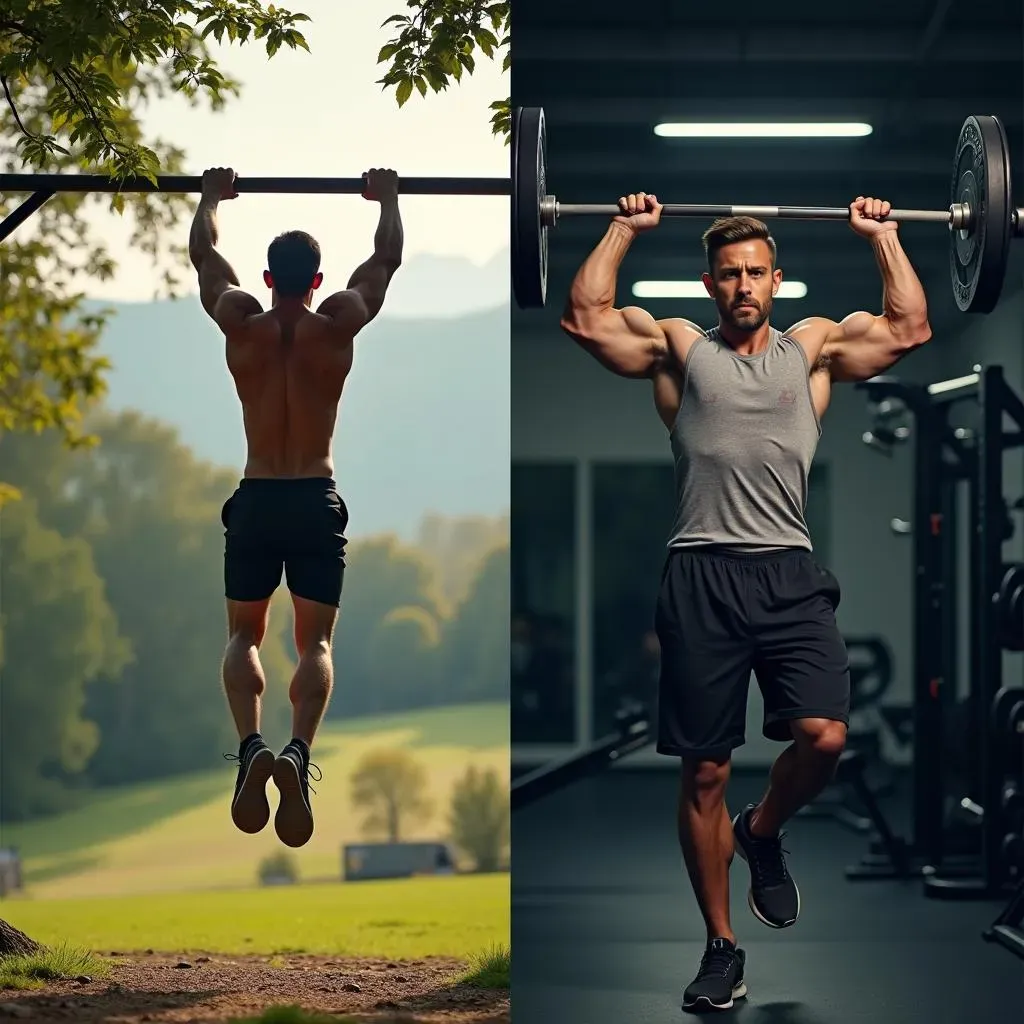Table of Contents
When it comes to strength training, two popular methods often come to mind: calisthenics and weightlifting. But is calisthenics the best way to achieve your fitness goals? Calisthenics, which uses body weight as resistance, has gained popularity for its convenience and effectiveness. However, weightlifting, which utilizes external weights, is also a proven method for building strength and muscle. As we delve into the world of strength training, it's essential to consider the pros and cons of each method. In this article, we'll explore the benefits and drawbacks of calisthenics and weightlifting, helping you decide which approach is best for your fitness journey. Whether you're a seasoned athlete or just starting out, understanding the differences between these two methods will empower you to make an informed decision and create a workout routine that suits your needs. So, let's dive in and examine the effectiveness of calisthenics and weightlifting, ultimately answering the question: is calisthenics the best choice for you?
What is Calisthenics and How Does it Compare to Weightlifting?

What is Calisthenics and How Does it Compare to Weightlifting?
Calisthenics is a form of strength training that uses body weight as resistance. It involves exercises like push-ups, squats, lunges, and planks, which work multiple muscle groups at once. This approach is ideal for those who prefer a more flexible and low-cost workout routine. On the other hand, weightlifting utilizes external weights, such as dumbbells or barbells, to provide resistance. Weightlifting is often preferred by those seeking to build significant muscle mass and strength.
One of the primary differences between calisthenics and weightlifting is the type of resistance used. Calisthenics relies on body weight, which can be modified to suit different fitness levels by adjusting the difficulty of exercises. Weightlifting, however, allows for more precise control over the amount of weight used, making it easier to progressively increase strength. Calisthenics tends to focus on compound exercises that engage multiple muscle groups, while weightlifting can be used for both compound and isolation exercises.
Exercise | Calisthenics | Weightlifting |
|---|---|---|
Push-ups | Body weight resistance | Dumbell press |
Squats | Body weight resistance | Barbell squats |
Lunges | Body weight resistance | Dumbell lunges |
Despite their differences, both calisthenics and weightlifting can be effective for improving overall fitness. Calisthenics is particularly beneficial for burning calories and increasing flexibility, while weightlifting is ideal for building strength and muscle size. Ultimately, the choice between calisthenics and weightlifting depends on individual fitness goals and preferences.
- Calisthenics is great for those who enjoy bodyweight exercises and need a flexible workout routine.
- Weightlifting is ideal for those seeking to build significant muscle mass and strength.
- Combining both methods can provide a well-rounded workout and help achieve overall fitness.
Benefits of Calisthenics: Why It's a Great Option for Overall Fitness

Benefits of Calisthenics: Why It's a Great Option for Overall Fitness
Introduction to Calisthenics Benefits
Calisthenics is an excellent way to improve overall fitness, offering numerous benefits that make it an attractive option for many. One of the primary advantages of calisthenics is its convenience. Since it uses body weight as resistance, you can perform calisthenics exercises anywhere, eliminating the need for specialized equipment or a gym membership. This flexibility makes it easier to incorporate physical activity into your daily routine, whether you're at home, in the park, or traveling.
Another significant benefit of calisthenics is its ability to improve flexibility and balance. Many calisthenics exercises, such as yoga and Pilates-inspired movements, focus on strengthening the core and increasing range of motion. This can lead to better posture, reduced injury risk, and enhanced overall athleticism. Furthermore, calisthenics tends to be a lower-impact activity compared to weightlifting, making it an excellent option for those who are recovering from injuries or have joint issues.
Exercise | Benefits | Calorie Burn |
|---|---|---|
Push-ups | Strengthens chest, shoulders, and triceps | 100-150 calories per 30 minutes |
Squats | Tones legs, glutes, and core | 150-200 calories per 30 minutes |
Plank | Improves core strength and stability | 50-100 calories per 30 minutes |
Calisthenics for Weight Loss and Muscle Endurance
Calisthenics is an effective way to burn calories and improve muscle endurance. High-intensity calisthenics workouts, such as burpees, jump squats, and mountain climbers, can burn a significant number of calories in a short amount of time. These exercises also improve cardiovascular health and increase muscle endurance, allowing you to perform daily tasks with more energy and efficiency.
In addition to weight loss and muscle endurance, calisthenics can help improve bone density. Weight-bearing exercises like squats and lunges stimulate bone growth, reducing the risk of osteoporosis and fractures. This makes calisthenics an excellent option for older adults or those with a family history of osteoporosis.
- Improved flexibility and balance
- Increased muscle endurance
- Weight loss and management
- Enhanced bone density
- Low-impact, reducing injury risk
Progressive Overload and Calisthenics
One of the common misconceptions about calisthenics is that it's not possible to progressive overload, which is essential for building strength. However, this couldn't be further from the truth. By modifying exercises to increase difficulty, you can challenge your muscles and continue making progress. For example, diamond push-ups, single-leg squats, and plyometric exercises like burpees and jump squats can provide the necessary overload to stimulate strength gains.
Another way to progressive overload in calisthenics is by increasing the number of repetitions or sets over time. As you get stronger, you can add more reps or sets to continue challenging your muscles. This approach may not be as precise as weightlifting, but it's an effective way to build strength and endurance using body weight.
The Drawbacks of Calisthenics: Is it Really the Best Choice for Everyone?

The Drawbacks of Calisthenics: Is it Really the Best Choice for Everyone?
Limitations of Calisthenics: Understanding the Drawbacks
While calisthenics offers numerous benefits, it's essential to acknowledge its limitations. One of the primary drawbacks of calisthenics is the difficulty in measuring progressive overload. Unlike weightlifting, where you can easily increase the weight to challenge your muscles, calisthenics relies on modifying exercises to increase difficulty. This can make it challenging to track progress and ensure you're continually challenging your muscles.
Another limitation of calisthenics is the potential for plateaus. As you become stronger, you may find it increasingly difficult to continue making progress. This can be frustrating, especially if you're not seeing the results you want. To overcome this, it's crucial to vary your workout routine and incorporate new exercises that target different muscle groups.
Exercise | Beginner | Intermediate | Advanced |
|---|---|---|---|
Squat | Bodyweight squat | Single-leg squat | Plyometric squat |
Push-up | Standard push-up | Diamond push-up | Clap push-up |
Lunge | Walking lunge | Alternating lunge | Jumping lunge |
Calisthenics for Muscle Building: Is it Enough?
Calisthenics can be an effective way to build muscle endurance, but when it comes to building significant muscle mass, it may not be enough on its own. This is because calisthenics often focuses on higher repetition ranges, which can improve endurance but may not provide the necessary stimulus for hypertrophy. Weightlifting, on the other hand, allows for lower repetition ranges with heavier weights, which is ideal for building muscle size.
If you're looking to build significant muscle mass, you may need to supplement your calisthenics routine with weightlifting. However, this doesn't mean you need to abandon calisthenics entirely. Many people find that combining both methods provides the best results, as calisthenics can help improve overall fitness while weightlifting focuses on building strength and muscle.
- Calisthenics is ideal for muscle endurance and higher repetition ranges.
- Weightlifting is better suited for building muscle size and strength.
- Combining both methods can provide a well-rounded workout.
Is Calisthenics Suitable for Everyone?
While calisthenics can be modified to suit different fitness levels, it may not be the best choice for everyone. For example, those with certain injuries or mobility issues may find it challenging to perform exercises that require a full range of motion. Additionally, calisthenics may not provide enough resistance for advanced individuals who have built significant strength through weightlifting.
It's essential to consider your individual needs and goals when deciding whether calisthenics is the best choice for you. If you're looking for a low-impact, flexible workout that can be done anywhere, calisthenics might be an excellent option. However, if you're seeking to build significant muscle mass or require more intense resistance training, weightlifting might be a better fit.
Calisthenics vs Weightlifting: Which One is Best for Your Fitness Goals?

Calisthenics vs Weightlifting: Which One is Best for Your Fitness Goals?
When it comes to choosing between calisthenics and weightlifting, the decision ultimately depends on your individual fitness goals and preferences. Both methods have their advantages and disadvantages, and understanding these differences is crucial to selecting the best approach for your needs.
Calisthenics is ideal for those who want to improve overall fitness, burn calories, and increase flexibility. It's a low-cost, convenient way to work out anywhere, without the need for specialized equipment. Weightlifting, on the other hand, is better suited for those seeking to build significant muscle mass and strength. It provides a more precise way to control the amount of weight used, allowing for progressive overload and muscle growth.
Goal | Calisthenics | Weightlifting |
|---|---|---|
Weight Loss | Effective for burning calories and improving cardiovascular health | Can be effective when combined with a calorie-controlled diet |
Muscle Endurance | Excellent for improving muscle endurance and stamina | Can improve muscle endurance, but may not be as effective as calisthenics |
Muscle Building | May not be enough for significant muscle growth | Ideal for building muscle mass and strength |
Ultimate, the choice between calisthenics and weightlifting comes down to your personal preferences and fitness objectives. If you're looking for a flexible, low-impact workout that can be done anywhere, calisthenics might be the best choice. However, if you're seeking to build significant muscle mass and strength, weightlifting is likely a better option.
- Consider your fitness goals: weight loss, muscle endurance, or muscle building
- Think about your lifestyle: do you prefer the convenience of calisthenics or the structure of weightlifting?
- Experiment with both methods to find what works best for you
Remember, both calisthenics and weightlifting can be effective for achieving overall fitness. By understanding the advantages and disadvantages of each method, you can make an informed decision and create a workout routine that suits your needs.
Combining Calisthenics and Weightlifting for a WellRounded Workout

Combining Calisthenics and Weightlifting for a WellRounded Workout
As we've explored the benefits and drawbacks of both calisthenics and weightlifting, it's clear that each method has its unique advantages. However, combining both can provide a well-rounded workout that addresses all aspects of fitness. By incorporating elements of both calisthenics and weightlifting, you can create a workout routine that improves cardiovascular health, increases strength, and enhances flexibility.
One approach to combining calisthenics and weightlifting is to alternate between the two. For example, you could dedicate certain days to calisthenics and others to weightlifting. This allows you to enjoy the convenience and flexibility of calisthenics while also benefiting from the progressive overload of weightlifting. Alternatively, you could incorporate weightlifting into your calisthenics routine by using resistance bands or light dumbbells to increase the challenge.
Another way to combine calisthenics and weightlifting is to use bodyweight exercises as a warm-up or finisher to your weightlifting routine. For example, you could start with a set of jumping jacks or burpees to get your heart rate up, then move into your weightlifting exercises. Alternatively, you could finish your weightlifting workout with a set of push-ups or squats to stretch your muscles and improve flexibility.
- Alternate between calisthenics and weightlifting days
- Incorporate resistance bands or light dumbbells into your calisthenics routine
- Use calisthenics as a warm-up or finisher to your weightlifting workouts
Creating a Hybrid Workout Routine
When creating a hybrid workout routine that combines calisthenics and weightlifting, it's essential to consider your fitness goals and schedule. You may want to focus on specific muscle groups or overall fitness. For example, if you're looking to improve your upper body strength, you could dedicate two days to weightlifting (bench press, rows, bicep curls) and one day to calisthenics (push-ups, pull-ups, dips). Alternatively, if you're focusing on lower body strength, you could do the opposite.
It's also important to allow for rest days to avoid overtraining and prevent injury. Your body needs time to recover and rebuild muscle tissue, so be sure to include at least one or two rest days per week. Additionally, progressive overload is crucial for continued progress, so gradually increase the intensity of your workouts by adding weight, reps, or sets over time.
Workout Split | Weightlifting Days | Calisthenics Days | Rest Days |
|---|---|---|---|
Upper/Lower Split | 2 | 1 | 2 |
Push/Pull/Legs Split | 3 | 1 | 1 |
By combining calisthenics and weightlifting, you can create a workout routine that addresses all aspects of fitness, from cardiovascular health to muscular strength and endurance. Remember to stay consistent, listen to your body, and make adjustments as needed to ensure continued progress and avoid injury.
- Consider your fitness goals and schedule when creating your hybrid routine
- Include rest days to allow for recovery and muscle growth
- Progressively overload your muscles to continue making gains
Conclusion: Finding the Best Approach for Your Fitness Goals
In conclusion, whether is calisthenics the best for you depends on your individual fitness goals and preferences. Calisthenics offers a convenient and effective way to improve flexibility and burn calories, while weightlifting provides a more intense strength training experience. By understanding the benefits and drawbacks of each method, you can make an informed decision and create a workout routine that suits your lifestyle. Remember, the key to success lies in consistency, patience, and progressive overload. Experiment with both calisthenics and weightlifting to find the perfect balance for your fitness journey. Ultimately, the best approach is one that combines the benefits of both methods, helping you achieve a well-rounded physique and optimal overall fitness. So, is calisthenics the best? The answer lies in your personal preferences and goals, but one thing is certain – incorporating calisthenics into your routine can be a game-changer.
